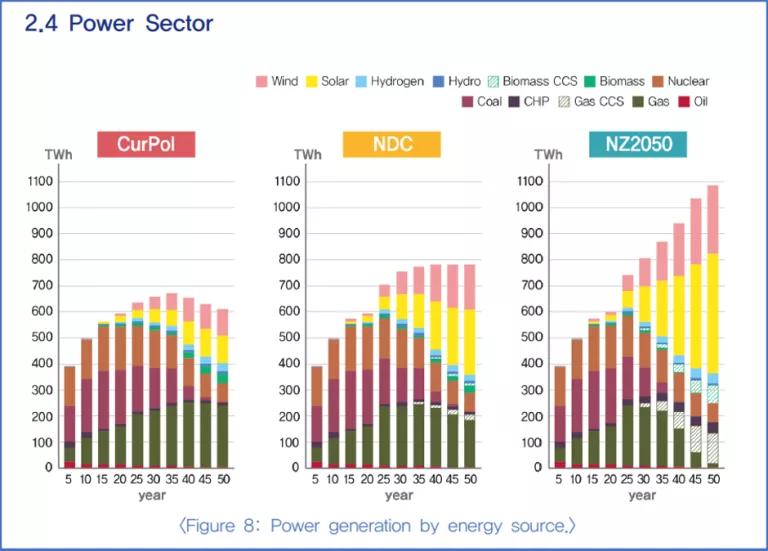Time for South Korea to Deliver Bold Climate Action: 50% Cut
When he meets with President Biden this week, South Korea President Moon Jae-in has a golden opportunity to show his country means business when it comes to tackling climate change and doing its part to protect the world from a climate catastrophe.

South Korean President Moon Jae-in at Climate Leaders Summit 2021
By: Jake Schmidt, Senior Strategic Director for International Climate, Natural Resources Defense Council (NRDC) and Joojin Kim, Managing Director, Solutions for Our Climate (SFO°C)
When he meets with President Biden this week, South Korea President Moon Jae-in has a golden opportunity to show his country means business when it comes to tackling climate change and doing its part to protect the world from a climate catastrophe.
President Moon Jae-in can do so, and position South Korea as a global leader on climate, by committing to cut his country’s climate-changing emissions 50 percent below 2017 levels and moving rapidly away from dirty sources of energy.
If not now, then the sooner the better. Such a bold move would be great news for the lives and livelihoods of people around the world and would enable South Korea to join the “50 Percent Club”—the growing group of future-minded countries committing to cut their emissions at least half by 2030 on the path to net zero emissions no later than 2050.
If South Korea makes that pledge, it will join major economies such as the U.S., Japan, European Union, and United Kingdom committing to be at least halfway to net zero by the end of this decade (see table). Such a commitment also would be a clear step towards keeping a global temperature rise to less than 1.5°C within reach—a level necessary to avoid the worst impacts of climate change to people and our planet.

South Korea’s current target is to cut emissions 24.4 percent below 2017 levels (six percent above 2005 levels) by 2030, without land-use emissions and sequestration. This is a level of commitment consistent with a 3-4°C world—a dangerous level that would cause devastation in South Korea and around the world. In recognition that the country needs to be more aggressive on climate change, South Korea recently committed to a goal of bringing their emissions to “carbon neutrality by 2050.” At the Climate Leaders Summit, President Moon Jae-in confirmed that they will strengthen their near-term ambition, stating: “the Republic of Korea will further raise our Nationally Determined Contribution for 2030 and submit it to the United Nations within this year.” To be consistent with that long-term target, South Korea will need to significantly strengthen their 2030 target under the Paris Agreement.
Now Is Not the Time for Small Steps
Leading groups in South Korea have called for the country to set a target of 59 percent below 2017 levels (42 percent below 2005 levels) in line with an international study of a 1.5°C aligned path for South Korea. Former Vice President Gore wrote to President Moon stating: “Research by the world’s leading climate experts has shown that an enhanced Korean NDC of at least 50% under 2017 emissions levels by 2030 is what is needed to remain consistent with a 1.5°C global pathway.”
There are signs that the U.S. is pushing South Korea to be bold. The acting Prime Minister of South Korea confirmed that Special Presidential Envoy for Climate John Kerry had urged South Korea to increase their 2030 target by at least 50 percent, phase-out coal early, and end public coal financing (see page 30 of this interaction before the National Assembly of South Korea).
There are indications that South Korea is considering a target of 40-50 percent below 2017 levels by 2030. A cut of less than 50 percent below 2017 levels by 2030 would fail to show the kind of global climate leadership that South Korea is capable of delivering.
A Bold 2030 Climate Target Is Possible
Using a globally respected model, researchers at Solutions for Our Climate (SFOC), the Korea Advanced Institute of Science and Technology (KAIST), and the University of Maryland Center for Global Sustainability found that South Korea could cut emissions decisively this decade on a path to net zero emissions by 2050. The report analyzed readily available technologies and strategies that are common in similar studies conducted in other countries: shifting from coal and natural gas to renewable energy, increasing energy efficiency, and increasing zero emissions vehicles. For just the power sector, the study found that by 2030 (see figure):
- the share of coal power generation would need to decrease to as little as 10% of the total power generation—effectively driven out of the power market;
- renewables would increase roughly seven-fold between 2020 and 2030; and
- around 2025 gas emissions in the power sector peak.

Source: KAIST and SFOC, 2050 Carbon-Neutrality Transition Scenario: Analysis of a Korean Integrated Assessment Model
Strong Climate Action Would Benefit South Korea and the World
Aggressive actions by South Korea will help tackle the twin challenges of air pollution and climate change. Coal-fired power plants are a significant source of air pollution in South Korea, which contributes to the country regularly exceeding the World Health Organization air pollution standards by a wide margin.
Rapidly phasing out South Korea’s coal power plants in line with a 1.5°C compatible pathway could halve the number of premature deaths linked to air pollution from South Korean coal plants within the next 5 years and save more than 18,000 lives, according to a recent study. And the health benefits would include fewer preterm births, less new asthma cases, and a significant reduction in lost days of work from health complications.
A strong 2030 climate target from South Korea will also be critical if the world has a chance of staving off the worst impacts of climate change. While no single country can solve the climate crisis, as the world’s 12th largest emitters, South Korea’s actions this decade are critical. Cutting emissions 50 percent instead of its current target would reduce its climate pollution more than 181 million tons in 2030—equivalent to having the entire country of the Netherlands at zero emissions per year.
A percent (or five) here or there may not seem significant, but they add up to a lot of tons that we, collectively, can ill afford to spew into the atmosphere. If South Korea were to cut emissions by 50 percent instead of 40 percent in 2030, 71 million less tons of carbon pollution per year would be emitted—more than the annual emissions of New Zealand.
Every ton and extra percent cut in South Korea’s greenhouse gas emissions is critical to putting the world on a safer climate trajectory this decade.
The Decisive Decade Needs Bold Leadership from South Korea
The actions taken by the end of 2030 are critical if the world is to have a chance of holding temperatures to less than 1.5°C. Some of the world’s largest economies have already committed bolder climate action this decade. South Korean President Moon Jae-in has a chance to join the growing group of countries committing to be halfway to net zero by the end of this decade. He should commit to cut emissions 50 percent below 2017 levels by 2030.
It is time to rise to this opportunity and set South Korea decisively toward adding no new carbon pollution to our overloaded atmosphere by 2050. That’ll usher in a future worth living for.




